Our man Jay Powell is talking a little more about raising rates. Right on cue, stocks have dropped, and dividend yields have popped!
Our contrarian buying opportunity is here.
But wait. Even with the latest pullback, the yields on the popular names of the S&P 500 are still only 1.3%. And how can you call the S&P 500 cheap when it still trades at a nosebleed P/E of 37?
You can’t.
But lucky for us, there are always overlooked assets out there. To find them, we’re going to skip the S&P and go with another acronym: “C-E-F,” for closed-end fund.
If you’ve heard of CEFs, you know that they’re famous for huge dividends. The 500 or so CEFs in existence yield 7%, on average, today.
With the cost of living spiking, you need a big income stream now more than ever. And switching from a portfolio of regular stocks to CEFs yielding 5%, 6%, 7% and higher is a savvy way to get one.
Swapping a 1% Payout for 6.8%
The cool part of all this is that you likely won’t have to sell your current stocks to get these payouts. Right now, I’m guessing you own one or more of Apple (AAPL), Microsoft (MSFT), Amazon.com (AMZN) or JPMorgan Chase & Co. (JPM). They’re the building blocks of many a portfolio.
But if you hold these stocks individually, you’re totally dependent on price gains: between them, they yield a pathetic 1%.
That’s far from the case for investors who buy the Adams Diversified Equity Fund (ADX). (Members of our CEF Insider service will likely recognize ADX—it’s a long-time holding.)
ADX holds all these stocks and has a unique setup where it pays most of its dividend as a year-end payout that can fluctuate. In 2020, that gave it a gaudy 6.8% yield.
Going the special-payout route is smart because it frees up management to buy bargains in a selloff. This is why ADX’s yield last year was lower than it has been in the past five:
ADX: A Dividend Machine
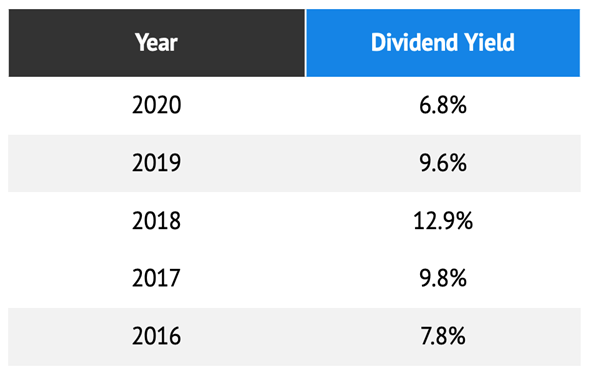
That helped the fund’s total NAV return—or how its portfolio performed with dividends included—soar 89% coming out of the March ’20 selloff:
ADX’s Stock Pickers Deliver
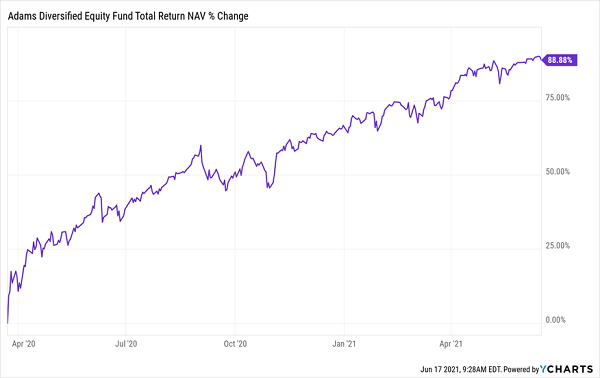
And if you’re still a little uncomfortable with ADX’s dividend policy, consider that no matter what, you’ll be pocketing at least a 6% annual yield—management commits to it right in the fund’s fact sheet!
Buying June’s Hot Stocks at January’s Prices
Here’s the funny thing: because ADX is a CEF, its market price and NAV trade at different levels, and currently its market price is below its NAV—and by quite a bit—13.8%, in fact.
That’s called a discount to NAV, and by buying into one, we can buy a CEF’s holdings (in this case, big-name stocks like Microsoft, Amazon, Apple and JPMorgan) at a discount to their actual prices (a 13.8% discount, for example, would be equal to buying Microsoft at January’s levels).
This is a quirk of CEFs that doesn’t exist in other types of funds. The biggest ETF of them all, the S&P 500–tracking SPDR S&P 500 ETF Trust (SPY), for example, constantly issues shares to keep its market price and portfolio value in line.
SPY: No Bargains Here
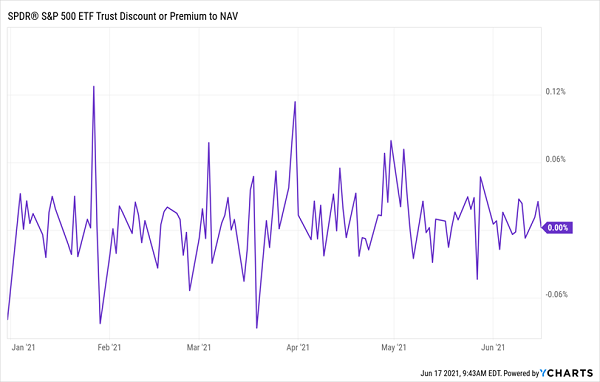
CEFs’ discounts are the biggest reason (besides the dividends!) why we love these funds—a narrowing discount can deliver us some spectacular returns indeed.
And the change in the discount doesn’t have to be large to propel a CEF’s price higher. Let’s swing back to ADX: in March ’20, its discount sunk to 17.6%. It’s narrowed to a still-wide 13.8% today, but that subtle shift helped deliver this:
ADX’s Market Price Outruns Its NAV

As you can see, the return ADX’s investors saw (in purple) surpassed the gain in its NAV (orange) as its discount narrowed. ADX’s market-price gain also surpassed the market’s 92% return in this period.
And when you find a discount that’s truly out of whack, you can ride it to some amazing outperformance.
Let’s rewind to January 6, 2021. Eagle-eyed CEF investors back then would have noticed that the Columbia Seligman Premium Technology Growth Fund (STK), which yields 5.3% today, was out of favor: its discount dropped to 5%, its lowest level since March 2020.
That’s bizarre for a fund holding top tech names like Apple, Microsoft, Alphabet (GOOGL) and Lam Research (LAM). Remember, too, that tech stocks were still darlings in January, as rising-rate fears hadn’t yet taken over.
STK’s Weird Sale
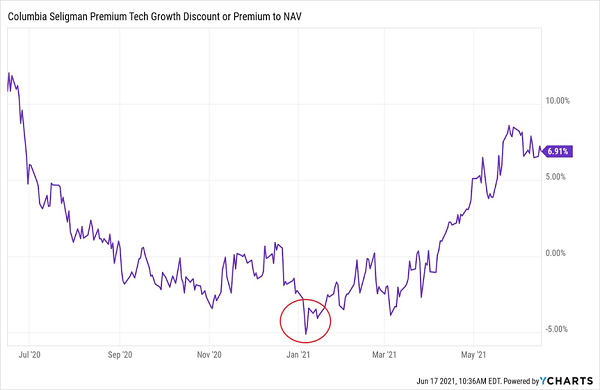
Since then, CEF investors have corrected their mistake—and then some. Today, STK trades at a 7% premium to NAV, meaning investors are willing to pay $1.07 for every dollar of STK’s assets!
It just shows how irrational the CEF market is, and how jumping in when that irrationality shows itself can generate market-crushing returns. Here’s what happened to STK’s market price as its discount flipped to a premium:
“Discount Catapult” Flings STK Past Every Benchmark
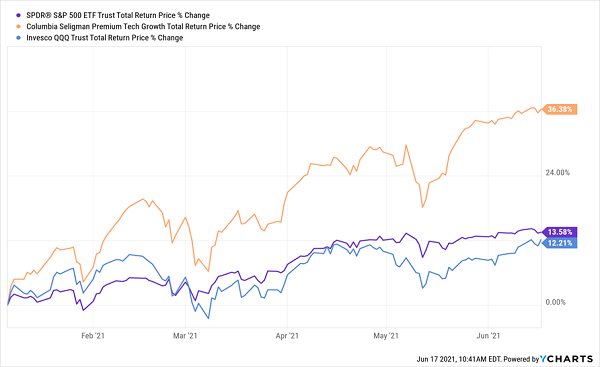
The kicker with CEFs is that they hand us a large slice of their returns in dividends. In today’s inflationary environment, the more dividend cash you have, the better!
Note From the Publisher
Kevin Wallen here. I’m the publisher at Contrarian Outlook.
If you’re on the hunt for big dividends (and who isn’t!?), I’ve got 5 picks you absolutely must know about.
Before you ask, yes, they’re CEFs. And they yield an outsized 7.3%, on average, with the highest payer of the bunch throwing off a massive 8.3% yield!
And talk about discounts: these 5 funds are so undervalued that Michael Foster, our CEF specialist, is calling for 20%+ price upside from each one in the next 12 months.
That amounts to a fast 27% return in gains and dividends! And this is Michael’s conservative estimate.
But because these are all smaller funds, there’s a limit to how many investors we can allow to access them now—and spots are going fast. Don’t miss out! Click here to get full details—names, tickers, dividend histories and everything you need to know—on these 5 high-yield CEFs.
